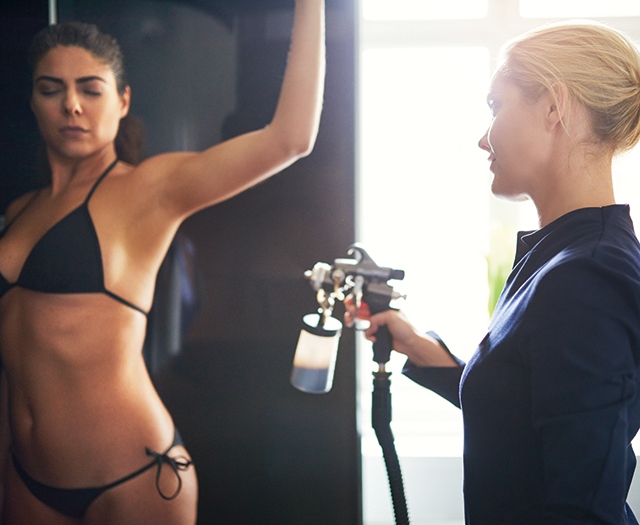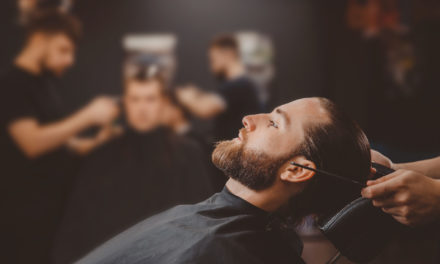They’re less harmful than sun and tanning beds, but dermatologists aren’t entirely sold.
Sonia Pena, a young mom with a strong interest in politics, health, and culture, likes having a tan glow to her skin, a little darker than her natural color.
Growing up in California’s Central Valley, she spent hours each hot summer at outdoor swimming pools, burning and tanning and having a blast. Now living in the Bay Area, Pena, 39, still likes a light tan but wants to avoid the risks of sun exposure. For a while, she liked tanning beds, especially for a year-round tan. But concern over exposure to unhealthy ultraviolet rays has sent Pena in a new direction — spray tanning salons.
She’s not alone. Spray tanning is a growing trend, according to market data research and anecdotal accounts. Standing near-naked getting misted by tanning spray is becoming a popular personal-preening routine, joining waxing, facials, pedicures, manicures, and the like.
While most dermatologists truly wish people would find ultimate beauty and sexiness in their natural-born untampered skin color, they welcome spray tanning as a less dangerous alternative to the cancer-causing UV rays of mother sun or tanning booth lamps. Dermatologists do, however, call for additional research on sunless tanning products with consumer guidelines to match.
“The American Academy of Dermatology does maintain that self-tanning — spray or lotion — with appropriate sun protection is safer than tanning by ultraviolet radiation,” said Dr. Akhil Wadhera, a dermatologist at Kaiser Permanente and chair of Kaiser’s Southern Alameda County Cancer Committee.
“There is no level of safe tan caused by the sun. Tanning booths and tanning in the sun both can cause the most dangerous type of skin cancer, called melanoma.”
However, he added, “we recommend the use of self-tanning lotions at home instead of spray tanning at the salons.”
To Pena, who goes to her favorite East Bay spray tanning salon about four times a year, it’s about an easy, affordable mood-lifter that doesn’t carry the serious consequences of UV rays.
“Now that I’m getting get older, the sun damaged spots are starting to show more,” Pena said. “Tanning actually evens everything out and camouflages the blemishes. I don’t have to wear as much makeup,” she said. “It hides flaws on my skin. It hides cellulite. It makes me feel better about my body image for sure, my outer appearance.”
And yes, she added, sexier too.
As a light-skinned Latina, Pena also said that she’s most comfortable being a little darker, in line with other Latinos. “Brown is beautiful for sure,” she said.
Pena said she’ll keep an eye on health concerns: “If it became strongly linked to health risks, I’d definitely stop. I’d probably be on the look out for a more natural alternative.”
According to industry data by private research firms, spray tanning is a $1 billion industry in the United States today, up from $750 million about five years ago, and growing. This growth is associated with increased awareness about the risks of UV tanning, along with more consumer choice in tanning products — tones, scents, moisturizers, hand spraying, or automatic spraying in a heated booth.
Wadhera said sunless tanning is “definitely a trend.”
Spray tanning is one option in a wide field of sunless tanning products, which include over-the-counter creams, oils, and foams. Sunless products, or fake tanners as they’re sometimes called, have been available since the 1960s when Coppertone introduced Quick Tan, or QT, an overnight tanning cream.
The chemistry has steadily advanced through the years from creating uneven, smelly fake-orangey coatings to more natural-looking even tans. Donald Trump jokes aside.
The active ingredient in topical sunless tanning products is dihydroxyacetone, or DHA, a naturally occurring sugar that interacts with proteins in the skin’s outer layer turning them darker. This side effect of DHA was discovered accidentally by scientists in the 1920s who noticed it blotched the skin when accidentally spilled or dripped. Research advanced along with the popularity of tanning.
Spay tans are temporary and fade over a week or two, as the affected dead skin cells naturally slough off.
DHA is approved by the Federal Drug Administration for external use, including in sunless tanning products. This leaves spray tanning in a kind of DHA regulatory black hole, since it’s sprayed on the outside or external body, as permitted, but can get into internal membranes — the eyes, mouth, lungs, vagina, or anus — through the process. The safety of DHA use on mucous membranes or delicate internal skin isn’t established.
“The FDA does not recommend it to be used in spray formulations as there is high risk of it being inhaled or for it to come in contact with mucous membranes — eyes, mouth/lips, nose, and groin area. The risks of this compound if used internally have not been studied enough in human subjects to determine if it is safe,” Kaiser’s Wadhera said.
This doesn’t mean using DHA for spray tanning is illegal if it’s used properly. The onus or responsibility is on industry to use it correctly and to inform and protect clients. The FDA doesn’t have cosmetic cops who bust salons. But it takes complaints and uses them for enforcement and policy. Local agencies such as city or county health departments also regulate tanning businesses.
An informal survey of spray tanning salons suggest there’s a lot to learn about approved use. Pena said her salon provides protective glasses but she tries to hold her breath during the process.
So, what’s the takeaway for sunless tanners who prefer standing in a booth to smearing themselves at home? Many skin experts, and the FDA, agreed on some basic tips.
• Regardless of what sunless tanning product you use or how you use it, apply UV protection or sunscreen (with at a sun protection factor of 30 or above) when you’re in the sun. Tanning products alone don’t provide UV protection.
• Stop spray tanning immediately if you notice an allergic reaction.
• Don’t spray tan if you have any kind of active skin rash such as eczema or psoriasis.
• Cover your eyes, mouth, and groin area when getting a spray tan, even if the salon doesn’t offer this protection.
• Encourage your salon to add protections for potential internal exposure and remind the salon that products with DHA are only approved for external use.
• The FDA, on its spray tan webpage, suggested you ask these questions: “Are consumers protected from exposure in the entire area of the eyes, in addition to the eyes themselves? Are consumers protected from exposure on the lips and all parts of the body covered by mucous membrane? Are consumers protected from internal exposure caused by inhaling or ingesting the product? If the answer to any of these questions is “no,” the consumer is not protected from the unapproved use of this color additive. Consumers should request measures to protect their eyes and mucous membranes and prevent inhalation.”
Report unsafe DHA use to the FDA online or by calling 800-332-1088. The FDA tracks reports and uses the information to make enforcement and regulatory decisions.
Meanwhile, most experts stress that people shouldn’t let worries about spray tanning send them back to the sun. And however you tan, always pack sunscreen.
“Unfortunately, our current culture still glorifies skin bronzing, which causes people to be attracted to this trend,” said Kaiser’s Wadhera. “Based on some recent studies, a majority of Americans still associate a tan with health, despite the risks of skin cancer. The media continues to make it worse by highlighting this trend. We dermatologists continue to recommend daily sunscreen use to our patients.”
















